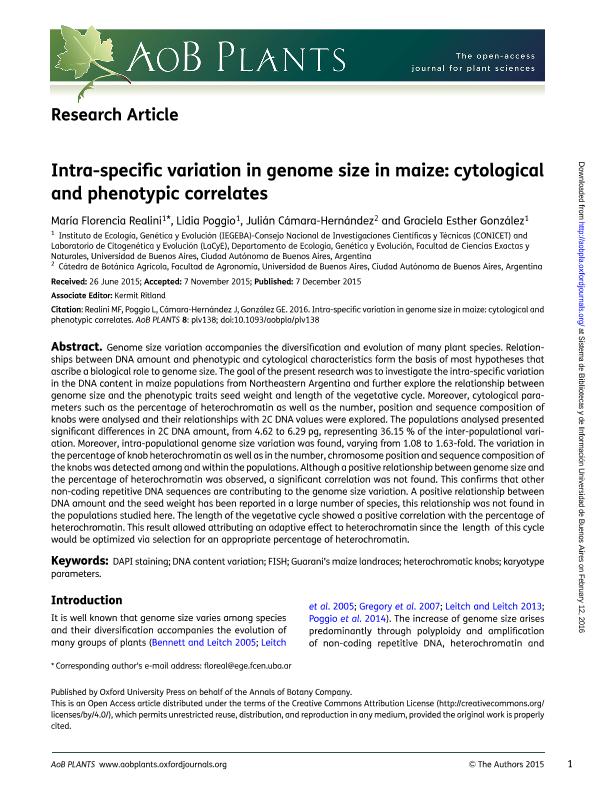Mostrar el registro sencillo del ítem
dc.contributor.author
Realini, Maria Florencia

dc.contributor.author
Poggio, Lidia

dc.contributor.author
Camara Hernandez, Julian Alberto

dc.contributor.author
González, Graciela Esther

dc.date.available
2018-09-14T20:50:25Z
dc.date.issued
2016-12
dc.identifier.citation
Realini, Maria Florencia; Poggio, Lidia; Camara Hernandez, Julian Alberto; González, Graciela Esther; Intra-specific variation in genome size in maize: Cytological and phenotypic correlates; Oxford University Press; AoB Plants; 8; 12-2016; 1-12
dc.identifier.issn
2041-2851
dc.identifier.uri
http://hdl.handle.net/11336/59806
dc.description.abstract
Genome size variation accompanies the diversification and evolution of many plant species. Relationshipsbetween DNA amount and phenotypic and cytological characteristics form the basis of most hypotheses thatascribe a biological role to genome size. The goal of the present research was to investigate the intra-specific variationin the DNA content in maize populations from Northeastern Argentina and further explore the relationship betweengenome size and the phenotypic traits seed weight and length of the vegetative cycle. Moreover, cytological parameterssuch as the percentage of heterochromatin as well as the number, position and sequence composition ofknobs were analysed and their relationships with 2C DNA values were explored. The populations analysed presentedsignificant differences in 2C DNA amount, from 4.62 to 6.29 pg, representing 36.15 % of the inter-populational variation.Moreover, intra-populational genome size variation was found, varying from 1.08 to 1.63-fold. The variation inthe percentage of knob heterochromatin as well as in the number, chromosome position and sequence composition ofthe knobswas detected among and within the populations. Although a positive relationship between genome size andthe percentage of heterochromatin was observed, a significant correlation was not found. This confirms that othernon-coding repetitive DNA sequences are contributing to the genome size variation. A positive relationship betweenDNA amount and the seed weight has been reported in a large number of species, this relationship was not found inthe populations studied here. The length of the vegetative cycle showed a positive correlation with the percentage ofheterochromatin. This result allowed attributing an adaptive effect to heterochromatin since the length of this cyclewould be optimized via selection for an appropriate percentage of heterochromatin.
dc.format
application/pdf
dc.language.iso
eng
dc.publisher
Oxford University Press

dc.rights
info:eu-repo/semantics/openAccess
dc.rights.uri
https://creativecommons.org/licenses/by-nc-sa/2.5/ar/
dc.subject
Dapi Staining
dc.subject
Dna Content Variation
dc.subject
Fish
dc.subject
Guarani'S Maize Landraces
dc.subject
Heterochromatic Knobs
dc.subject
Karyotype Parameters
dc.subject.classification
Otras Ciencias Biológicas

dc.subject.classification
Ciencias Biológicas

dc.subject.classification
CIENCIAS NATURALES Y EXACTAS

dc.title
Intra-specific variation in genome size in maize: Cytological and phenotypic correlates
dc.type
info:eu-repo/semantics/article
dc.type
info:ar-repo/semantics/artículo
dc.type
info:eu-repo/semantics/publishedVersion
dc.date.updated
2018-09-14T13:18:47Z
dc.journal.volume
8
dc.journal.pagination
1-12
dc.journal.pais
Reino Unido

dc.journal.ciudad
Oxford
dc.description.fil
Fil: Realini, Maria Florencia. Consejo Nacional de Investigaciones Científicas y Técnicas. Oficina de Coordinación Administrativa Ciudad Universitaria. Instituto de Ecología, Genética y Evolución de Buenos Aires. Universidad de Buenos Aires. Facultad de Ciencias Exactas y Naturales. Instituto de Ecología, Genética y Evolución de Buenos Aires; Argentina
dc.description.fil
Fil: Poggio, Lidia. Consejo Nacional de Investigaciones Científicas y Técnicas. Oficina de Coordinación Administrativa Ciudad Universitaria. Instituto de Ecología, Genética y Evolución de Buenos Aires. Universidad de Buenos Aires. Facultad de Ciencias Exactas y Naturales. Instituto de Ecología, Genética y Evolución de Buenos Aires; Argentina
dc.description.fil
Fil: Camara Hernandez, Julian Alberto. Universidad de Buenos Aires. Facultad de Agronomía; Argentina
dc.description.fil
Fil: González, Graciela Esther. Consejo Nacional de Investigaciones Científicas y Técnicas. Oficina de Coordinación Administrativa Ciudad Universitaria. Instituto de Ecología, Genética y Evolución de Buenos Aires. Universidad de Buenos Aires. Facultad de Ciencias Exactas y Naturales. Instituto de Ecología, Genética y Evolución de Buenos Aires; Argentina
dc.journal.title
AoB Plants
dc.relation.alternativeid
info:eu-repo/semantics/altIdentifier/doi/http://dx.doi.org/10.1093/aobpla/plv138
dc.relation.alternativeid
info:eu-repo/semantics/altIdentifier/url/https://academic.oup.com/aobpla/article/doi/10.1093/aobpla/plv138/2609491
Archivos asociados
